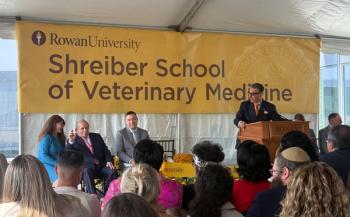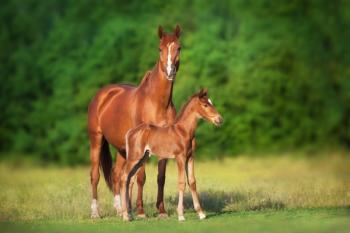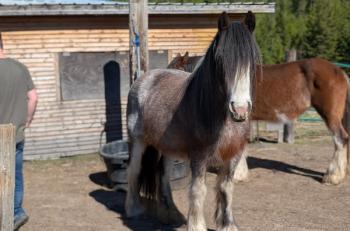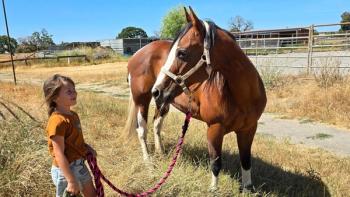
Gastrointestinal, musculoskeletal and neoplastic disorders of the older horse (Proceedings)
Older horses can present with the same problems as the younger horse but there are a few specific problems that occur with age or worsen with age.
Older horses can present with the same problems as the younger horse but there are a few specific problems that occur with age or worsen with age. The last hour we spoke about PPID which is predominantly age related. During this talk we will address how other organs systems are affected by age. As seen in both a hospital study and an owner survey of medical problems in the elderly equine, gastrointestinal, musculoskeletal and neoplastic diseases were the most common presentation.
Gastrointestinal
GI disease in the older horse represents a significant problem. NAHMS Equine '98 estimated that horses > 20 years of age experienced approximately 4 colics/100 horses – this was no real different from other ages. That said the incidence of certain types of colic appear to be more common in the older horse. Three separate studies indicated that it was the most prevalent system affected in horses over 20 years of age. Williams (2000) looked at the body systems represented in horses over 15 at post mortem. He found that it was the most common reason for death. The lesions varied but included intestinal volvulus, displacements and ruptures.
Strangulating lipomas were the most prominent problem in the 15-20 and 20-25 age groups. Brosnahan showed that 45% of horses > 20 years of age presenting to a hospital for colic had large colon problems while 40% of the cases were small intestinal lesions. Forty percent of the small intestinal problems were due to lipomas. Edwards also reports a significant increase in risk of pedunculated lipomas in older geldings and ponies. In this study of 75 strangulating lipomas – 70 involved small intestine and 5 involved small colon. The lipomas originated distant to mesenteric border.
Obviously a strangulating lesion requires surgery for correction. Owners often are unsure whether to send the 20+ horse to surgery thinking that they have a decreased survival. Provost found that though older horses had a somewhat decreased change of survival compared to the younger cohort, it was more a factor of the type of lesion found rather than the age of the horse.
For example an older horse with a large colon displacement had the same survival rate as a younger horse and an old horse with small intestinal strangulation had the same survival rate as a young horse. Older horses were more likely to have a small intestinal lesion which carries a higher mortality. In the hospital study, 50% of the horses over 20 that had colic surgery were discharged from the hospital while 50% were euthanized either on the table or before discharge.
Large colon impactions were the fifth most common specific disease process in the older horse according to the Brosnahan study. Ralston et al found that horses between 20-35 years of age had a notable reduction in the ability to digest crude protein, phosphorus and fiber. Dental disease may also contribute to a decrease in digestibility of nutrients and result in large fibers entering the large colon thereby predisposing to simple obstructions. Esophageal choke is also a consequence of poor dentition in horses. Signs of dental disease include weight loss, evidence of “quids” in the stall - chewed up clumps of hay around the feed bunk, foul odor to the breath, undigested grain in the manure and reluctance to eat.
Studies suggest high level of untreated dental disease. Owners are often unaware of a problem with only 8% of animals actually presented with dental problems in their history. When owners were asked about their horses eating habits, they reported that 21% of old horses quid (overlap of 1 horse), suggesting undiagnosed dental disease.
In the survey study owners reported that dental care was provided less than once yearly in 11% of older horses. Dental care was provided by DVM's 49% of the time in older horses with the remaining care being provided by dental technicians.
As the horse ages the teeth continue to wear down. Even the horse that has had good dental care all its life can develop a “smooth” mouth. Smooth mouth occurs as the normal wearing down of the enamel ridges of the teeth. This process may be hastened by chronic ingestion of sand or overly aggressive floating practices. As the tooth continues to wear down it may appear as 2 teeth – this is because the tooth is worn to the level of the roots. Radical correction of severe dental disease may not be effective in improving the animal's ability to eat forage.
Shortening the height of abnormally long and sharp teeth should be considered to improve the comfort of the animal. Changes to dietary management may be necessary. Alternative forages include grass, hays with minimal stem and soaked hay cubes or haylage. Senior feeds, particularly extruded complete feeds, may be necessary to maintain body condition. Be aware of caloric density of brand that you are using. Some feeds are very light and if fed on volume basis instead of weight basis, you could be significantly reducing the caloric intake of your horse.
Musculoskeletal disorders
Musculoskeletal problems were the second most common presenting complaint in the Brosnahan hospital study. Of the horses presenting for lameness - 37.5% had laminitis (mostly in conjunction with PPID) and 55% had lamenesses that were classified as degenerative disease. Older horses were significantly more likely to be taking long term medications than younger horses. The most prevalent medication taken by older horse fell in the NSAID and chondroprotective category. One can assume that this is an indication of chronic musculoskeletal pain.
It is hypothesized that earlier injury to joints, muscles, tendons and ligaments set up the geriatric horse for progressive degenerative changes in the musculoskeletal system. Loss of shock absorption is due to chronic inflammatory changes in the synovial fluid, cartilage defects and sclerosis of subchondral bone. Osteophytes are hallmark of osteoarthritis. Cartilage research in old horses demonstrated that GAG levels remain constant throughout life, but there is age-related decreases in proteoglycan size though the loss of GAG chains. (Platt et al, 1998)
Older horses have greater pentosidine crosslinks which may predispose older horses to osteochondral disease due to stiffer and more brittle cartilage. (Brama et al, 1999) A progressive degeneration of the suspensory ligaments in the hind limb is seen in some geriatric horses (particularly older broodmares). Clinically these horses have straight hock conformation and progressive sinking of the fetlocks.
Management of osteoarthritis in the older horses involves judicious use of NSAID's drugs and increasing mobility. Increasing the mobility of the animal plays a role in the decreasing of pain. One should avoid stall rest in these animals. Unlimited turnout is preferred. If the older horse is still in work, modifications to the training program may need to be implemented. Older horses will probably take longer to become physically fit – so extra time will be needed in your conditioning program. Older horses will fatigue quicker than younger horses – so resting between strenuous activities may be necessary.
Continuous low level work will be better for the older horse than a “weekend warrior” session! The addition of nutraceuticals such as glucosamine-chondroitin sulfate has been shown to improve lameness grade, flexion test grade and stride length in horses with osteoarthritis. Acupuncture, chiropractic and massage therapy may be helpful in the older horse that has multiple problems.
Neoplasm
Squamous cell carcinoma and melanomas are the 2 tumor types that increase with age. Sqaumous cell carcinoma is the most prevalent. It is most commonly seen on the eye and equine penis and prepuce. Masses may be single or multiple. In one study, affected animals had a mean age of 16.5 years of age. The lighter, non-pigmented skin is more susceptible to development of tumors. It spreads by metastasis to corpus cavernosum penis and inguinal lymph nodes.
Approximately 80% of older gray horses have evidence of external melanomas. These rarely metastasize but in a study of CNS tumors, melanomas were the 2nd most prevalent and appear to be age related.
Older horses can lead healthy lives into their 30's, particularly if care is taken to address problems as soon as they are recognized.
Newsletter
From exam room tips to practice management insights, get trusted veterinary news delivered straight to your inbox—subscribe to dvm360.






